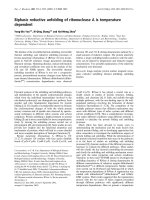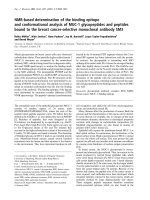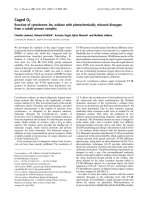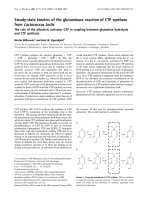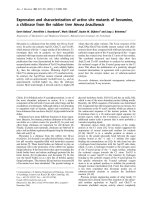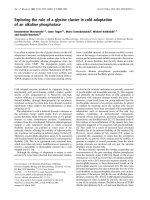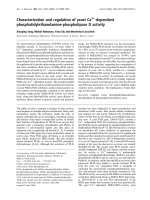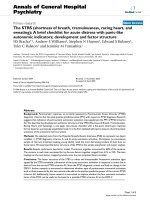Báo cáo y học: "Colour duplex sonography of temporal arteries before decision for biopsy: a prospective study in 55 patients with suspected giant cell arteritis" pptx
Bạn đang xem bản rút gọn của tài liệu. Xem và tải ngay bản đầy đủ của tài liệu tại đây (819 KB, 8 trang )
Open Access
Available online />Page 1 of 8
(page number not for citation purposes)
Vol 8 No 4
Research article
Colour duplex sonography of temporal arteries before decision for
biopsy: a prospective study in 55 patients with suspected giant cell
arteritis
Maria Karahaliou
1
, George Vaiopoulos
2
, Spiros Papaspyrou
1
, Meletios A Kanakis
2
,
Konstantinos Revenas
1
and Petros P Sfikakis
2
1
Radiology Department, Laikon Hospital, 17 Agiou Thoma Street, Athens, 11527, Greece
2
First Department of Propedeutic Medicine, Laikon Hospital, 17 Agiou Thoma Street, Athens, 11527, Greece
Corresponding author: Petros P Sfikakis,
Received: 22 Mar 2006 Revisions requested: 10 May 2006 Revisions received: 27 Jun 2006 Accepted: 30 Jun 2006 Published: 19 Jul 2006
Arthritis Research & Therapy 2006, 8:R116 (doi:10.1186/ar2003)
This article is online at: />© 2006 Karahaliou et al.; licensee BioMed Central Ltd.
This is an open access article distributed under the terms of the Creative Commons Attribution License ( />),
which permits unrestricted use, distribution, and reproduction in any medium, provided the original work is properly cited.
Abstract
Although a temporal artery biopsy is the gold standard for the
diagnosis of giant cell arteritis (GCA), there is considerable
evidence that characteristic signs demonstrated by colour
duplex sonography (CDS) of the temporal arteries may be of
diagnostic importance. We aimed to test the hypothesis that
CDS can replace biopsy in the algorithm for the approach to
diagnose GCA. Bilateral CDS was performed in consecutive
patients older than 50 years with clinically suspected GCA, as
well as in 15 age- and gender-matched control subjects with
diabetes mellitus and/or stroke and 15 healthy subjects, to
assess flow parameters and the possible presence of a dark
halo around the arterial lumen. Unilateral temporal artery biopsy
was then performed in patients with suspected GCA, which was
directed to a particular arterial segment in case a halo was
detected in CDS. Final diagnoses, after completion of a 3-month
follow-up in 55 patients, included GCA (n = 22), polymyalgia
rheumatica (n = 12), polyarteritis nodosa, Wegener's, and
Adamantiades-Behçet's diseases (n = 3), and neoplastic (n = 8)
and infectious diseases (n = 10). A dark halo of variable size
(0.7–2.0 mm) around the vessel lumen was evident at baseline
CDS in 21 patients (in 12 and 9 uni- or bilaterally, respectively)
but in none of the controls. The presence of unilateral halo alone
yielded 82% sensitivity and 91% specificity for GCA, whereas
the specificity reached 100% when halos were found bilaterally.
Blood-flow abnormal parameters (temporal artery diameter,
peak systolic blood-flow velocities, stenoses, occlusions) were
common in GCA and non-GCA patients, as well as in healthy
and atherosclerotic disease-control, elderly subjects. At follow-
up CDS examinations performed at 2 and 4 weeks after initiation
of corticosteroid treatment for GCA, halos disappeared in all 18
patients (9 and 9, respectively). We conclude that CDS, an
inexpensive, non-invasive, and easy-to-perform method, allows a
directional biopsy that has an increased probability to confirm
the clinical diagnosis. Biopsy is not necessary in a substantial
proportion of patients in whom bilateral halo signs can be found
by CDS.
Introduction
Giant cell arteritis (GCA), or temporal arteritis, is the most
common form of systemic inflammatory vasculitis in adults.
GCA is a panarteritis that insults older people almost exclu-
sively. Because extracranial branches of the carotid artery are
commonly affected, the most dreadful complication of the dis-
ease is blindness, which should be prevented by high index of
suspicion and timely treatment with corticosteroids [1]. Given
the lack of specificity both of the clinical and laboratory data
[2], a temporal artery biopsy is always included in the algorithm
for the approach to diagnose GCA [3]. For purposes of clas-
sification, the American College of Rheumatology (ACR) pro-
poses that a patient with vasculitis is said to have GCA if three
of the following five criteria are present: (a) age 50 years or
above, (b) new onset of localized headache, (c) temporal
artery tenderness on palpation or decreased pulsation, (d)
erythrocyte sedimentation rate (ESR) of 50 mm/hour or more,
and (e) histologic findings [4]. However, although a temporal
artery biopsy is the diagnostic gold standard for this disease
ACR = American College of Rheumatology; CDS = colour duplex ultrasonography; CI = confidence interval; ESR = erythrocyte sedimentation rate;
GCA = giant cell arteritis.
Arthritis Research & Therapy Vol 8 No 4 Karahaliou et al.
Page 2 of 8
(page number not for citation purposes)
[5-7], biopsy results may be negative in 9% to 44% of patients
with a clinical diagnosis of GCA [6-8].
Schmidt and colleagues were the first to propose ultrasonog-
raphy as a quick, easy, and non-invasive test for identifying
GCA, before biopsy [9-11]. These studies suggested that the
presence of the halo sign (that is, a dark area around the ves-
sel lumen probably due to arterial wall edema) is highly spe-
cific for GCA. This hypoechoic finding is circumferential and
has to be demonstrated in two planes. Apart from the halo
sign, stenoses and occlusions of the temporal arteries, fre-
quently detected in acute disease, were recognized by
Schimdt and co-authors as additional characteristic signs in
patients suspected of having GCA [9,10]. The diagnostic
value of colour duplex sonography (CDS), however, remains
the subject of debate; Salvarani et al. have found that CDS
does not improve the diagnostic accuracy of a careful clinical
examination [12]. To further examine the diagnostic value of
CDS in patients with suspected GCA, we designed a pro-
spective study to specifically test the hypothesis that CDS can
replace biopsy in the algorithm for the approach to diagnose
GCA in the clinical setting.
Materials and methods
Protocol
Sixty consecutive patients aged 50 years or above who pre-
sented at the outpatient Rheumatology or Internal Medicine
Clinics at Laikon Hospital (Athens, Greece) between 2000
and 2004 with clinical suspicion of GCA were prospectively
studied. Provided that no other diagnosis could be established
after a complete medical history, clinical examination, and rou-
tine laboratory examinations and chest X-ray, the inclusion cri-
teria included at least one of the following: an ESR of 50 mm/
hour or more, new headache onset, jaw claudication, fever,
polymyalgia rheumatica, temporal artery tenderness, and
recent visual impairment.
In parallel with the diagnostic work-up required for these
patients, a baseline CDS of the temporal arteries was per-
formed prior to the initiation of treatment. Unilateral biopsy of
the temporal artery was subsequently performed within 1 to 5
days in 49 of the 55 patients who were included in the analy-
sis. Biopsy was directed to a particular temporal artery seg-
ment in those patients in whom a halo sign in CDS was found.
Irrespectively of the biopsy results, patients had to complete a
3-month follow-up to establish the final diagnosis, while CDS
was repeated in 14 ± 1 day intervals after the initiation of treat-
ment in those with abnormal baseline examination.
CDS of the temporal arteries was also performed in 15 age-
and gender-matched healthy subjects (mean age 72, range
50–88 years), as well as in 15 patients with diabetes mellitus
and/or stroke (mean age 73, range 51–92 years), who served
as healthy and disease controls, respectively. Temporal artery
biopsy was not performed in control subjects. The study pro-
tocol was ethically approved, and all subjects gave informed
consent.
Ultrasonography
All examinations were performed by at least one of three
sonographers (MK, SP, and KR) using a Logic 500 MD, (Gen-
eral Electric Chicago, IL, USA), ultrasound system. Sonogra-
phers were experienced radiologists who were unaware of the
presenting clinical findings of patients with suspected GCA at
baseline. Studies in control subjects and follow-up examina-
tions were performed in an unblinded manner. A high-resolu-
tion linear array (LA 39) 7- to 11-MHz transducer (General
Electric) was used (length 45 mm). Superficial temporal arter-
ies and frontal and parietal rami (to their distal points) were
examined to assess temporal artery blood-flow parameters
and the possible presence of a dark halo around the arterial
lumen. System settings (most of them always uniform, some of
them case-adjusted) were as follows: dynamic range 48 dB,
colour gain: 20–26, type of colour gain V-6, wall filter less than
100 Hz, velocity scale 9–13 m/s, focus point position 5–7 mm
(adjusted to vessel depth), zoom factor 1.5, signal volume
length 1.
Table 1
Baseline characteristics and final diagnoses in 55 patients with
clinically suspected GCA
Findings GCA (n = 22) Miscellaneous
diagnoses (n = 33)
Age 50 years or above 22 33
Elevated ESR 19 30
Fever 9 19
New onset of headache 14 10
Diffuse musculoskeletal pain 7 15
Jaw claudication 3 0
Temporal artery tenderness 8 3
Acute visual impairement 5 2
CDS, colour duplex ultrasonography; ESR, erythrocyte
sedimentation rate; GCA, giant cell arteritis.
Figure 1
Normal common temporal arteryNormal common temporal artery. Demonstration of the left superficial
temporal artery trunk by colour duplex sonography in a healthy person.
Longitudinal (right panel) and transverse (left panel) planes.
Available online />Page 3 of 8
(page number not for citation purposes)
Briefly, the principles of the method were as follows: By CDS,
the anatomical route of the temporal artery could be presented
in longitudinal and transverse view (Figure 1). The trunk of the
superficial temporal artery could rather easily be found when
the artery passes anterior to the tragus. From that point, the
artery is bifurcated to frontal and parietal rami. Although the
proximal segment of the artery trunk was not visible with B-
mode (because it is not covered by fascia), the distal segment
of the temporal artery trunk and both rami are embedded
between the two layers of the fascia temporalis, which could
be detected in B-mode as two parallel bright lines (Figure 2).
Absent flow in the temporal artery was considered as arterial
occlusion. In that case, detection of the temporal artery can be
achieved by B-mode, except of the very proximal segment of
the trunk. Segmental increase of blood-flow velocity, perhaps
with waveforms indicating turbulence, was classified as sten-
osis in case it could not be attributed to other abnormalities
(that is, artery kinking or atherosclerotic lesions). Stenosis was
considered to be present in an area where (a) blood-flow
velocity became at least double compared with the flow veloc-
ity recorded in the area right before, (b) there was local flow
turbulence, and (c) there were low blood-flow velocities at the
arterial segment right after. Measurements of the sagittal diam-
eter of the systolic lumen, wall thickness, and peak systolic
velocities were performed at the following three anatomical
sites: (a) trunk: in front of the tragus, (b) parietal ramus: 15 mm
distal of bifurcation, and (c) frontal ramus: 25 mm distal of
bifurcation. When a stenosis was present at these points,
measurements were performed 3–5 mm proximal. Finally, hyp-
oechogenic ring areas, which appeared around the lumen of
the temporal artery and could be detected in one or more sites
unilaterally or bilaterally, were defined as halos. Measurements
of the halo length and sagittal diameter at longitudinal and
transverse level were also performed.
Results
Baseline characteristics and final diagnoses in patients
with clinically suspected GCA
Of 60 consecutive patients with clinically suspected GCA
who entered the study, five patients did not complete the 3-
month follow-up and were excluded from the analysis. In the
55 patients, a final diagnosis was established and was then
confirmed by follow-up and histology. Baseline clinical charac-
teristics in GCA (mean age 70, range 52–90 years, 13
women) and non-GCA patients (mean age 74, range 50–91
years, 17 women) are shown in Table 1. ESR at 1 hour ranged
from 40 to 129 (mean 88) and from 34 to 119 (mean 60) in
GCA and non-GCA patients, respectively. Final diagnoses
included GCA (n = 22), polymyalgia rheumatica (n = 12), pol-
yarteritis nodosa, Wegener's, and Adamantiades-Behçet's
disease (n = 3), and neoplastic (n = 8) and infectious diseases
(n = 10) (Table 2). Considering the final diagnosis, an elevated
ESR had a sensitivity of 86% but a low specificity of 9%. Both
sensitivity and specificity of fever, new headache onset, and
diffuse musculoskeletal pain were modest, whereas jaw clau-
dication, temporal artery tenderness, and acute visual impair-
ment had high specificity but low sensitivity for GCA diagnosis
(Table 3).
Diagnostic value of the halo sign in temporal artery CDS
In 21 of 55 patients with clinically suspected GCA, a concen-
tric, hypoechogenic halo suggesting temporal artery wall
inflammation was detected at baseline (Figure 3). Halos were
detected at one or more sites of the artery. Although an inflam-
matory wall thickening was evident along the whole length of
a particular branch in some cases, a segmental, patchy
appearance of distinct, well-defined halos (length ranging
between 5 and 15 mm) was evident in CDS. Halos' sagittal
diameter ranged from 0.7 to 1.3 mm and in one case
approached 2.0 mm. The halo sign was either a unilateral or a
bilateral finding in 12 and 9 patients, respectively (Table 2). No
Figure 2
Parietal ramus of a normal temporal arteryParietal ramus of a normal temporal artery. Longitudinal view of the perfused lumen in colour duplex sonography; the bright area around the lumen
represents the arterial wall plus the temporal fascia (right panel). With B-mode, the artery wall is still visible as two parallel bright lines (left panel).
Arthritis Research & Therapy Vol 8 No 4 Karahaliou et al.
Page 4 of 8
(page number not for citation purposes)
halo could be demonstrated in any of the age- and gender-
matched healthy control subjects or controls with diabetes
mellitus and/or stroke (Table 2).
As shown in Table 2, the halo sign was present in 18 of 22
patients with GCA, and directional biopsies confirmed the
diagnosis in all. In three additional cases (2 patients with infec-
tious diseases and 1 patient with Wegener's granulomatosis;
Table 2), a unilateral halo sign was found in CDS. In the first
case, a vein neighbouring an artery was mistaken for a halo;
the final diagnosis was a flu-like syndrome. In the second case,
the final diagnosis was tuberculosis infection; biopsy results
were negative for GCA in both patients. The third patient had
a hypoechogenic halo of 0.6–1.1 mm at the right common
superficial temporal artery and was finally diagnosed with
Wegener's granulomatosis, a condition in which involvement
of temporal arteries has been described [12-14]. A temporal
artery biopsy, which albeit was not directed in this particular
patient, was negative for vasculitis.
Of the four GCA patients without halo signs in CDS, a tempo-
ral artery biopsy (arterial segment ≈ 3 cm) confirmed the diag-
nosis in three; the last patient had a negative biopsy, but
follow-up and the successful introduction of corticosteroid
treatment made other diagnoses unlikely.
As shown in Table 3, the presence of a halo sign alone yielded
82% sensitivity (95% confidence intervals [CIs]: 71.85%–
92.2%) and 91% specificity (95% CIs: 83.4%–98.6%) for the
diagnosis of GCA, whereas the positive and negative predic-
tive values were 86% and 88%, respectively. Although the
presence of bilateral halo signs was not common (sensitivity
41%, 95% CIs: 28%–59%), the specificity of this finding
reached 100%. Histology results were obtained in all 22 GCA
patients and in 27 of 33 non-GCA patients, but because all 18
positive biopsies in GCA patients were directed to a particular
arterial segment after obtaining the CDS results, the true value
of the temporal artery biopsy alone for the diagnosis of GCA
could not be estimated in our patients.
Temporal artery flow abnormalities
As shown in Table 2, various flow abnormalities, mainly seg-
mental stenoses (Figure 4), were detected by CDS in 18 of 55
patients with clinically suspected GCA, as well as in 11 of 30
control subjects, indicating that flow abnormalities of the tem-
poral arteries could not discriminate the patients with GCA.
Among the patients with suspected GCA, one had occlusion
of the frontal ramus. Flow velocity was lower at halo sites in
many patients. However, low flow velocities were also evident
in patients without GCA as well as in control elderly subjects
with or without diabetes mellitus and/or stroke. Mean values of
parameters such as lumen systolic diameter and maximum
systolic velocity, measured at three anatomical points as
described in Materials and methods, were not significantly dif-
ferent between patients with suspected GCA and age- and
gender-matched controls (data not shown).
Follow-up CDS examinations
Follow-up results obtained 14 ± 1 days from baseline in those
patients with negative CDS examination remained unremarka-
ble. Notably, halo signs disappeared in all 18 patients who
were diagnosed with GCA within a mean of 22 days after ini-
tiation of corticosteroid treatment. In nine of these patients,
halos were not detectable at the 2-week time point, whereas
in the remaining patients, halos disappeared at the 4-week
time point. Further examinations were unremarkable. The halo
was visible in the patient with Wegener's granulomatosis for 2
months after the initiation of treatment without any significant
change in echogenity and disappeared thereafter. Finally, the
halo sign in the patient with tuberculosis was reproducible at
the first, but not at the second, follow-up examination.
Discussion
A careful physical examination, including palpation of the tem-
poral arteries, accompanied by an accurate medical history
Figure 3
Halo sign in colour duplex sonography examination in a patient with giant cell arteritisHalo sign in colour duplex sonography examination in a patient with
giant cell arteritis. Hypoechoic area around the temporal artery trunk in
longitudinal (upper panel) and transverse (lower panel) views.
Available online />Page 5 of 8
(page number not for citation purposes)
and laboratory data are all imperative for the diagnosis of GCA
[12,16]. Moreover, clinicians should be familiar with the atypi-
cal presentation of the disease, including fever of unknown ori-
gin, respiratory tract symptoms, and large artery involvement
[1]. Symptoms such as jaw claudication and diplopia signifi-
cantly increase the probability to diagnose GCA [16,17]. In
our prospective study, visual disorders and jaw claudication at
baseline were associated with high specificity, albeit with low
sensitivity. Although jaw claudication had 100% specificity,
only three of our 22 patients with GCA reported this symptom.
This frequency is clearly lower than expected [1-3], but similar
findings have been reported in other cohorts of patients with
GCA [18].
Accumulated evidence suggests that of greater sensitivity
than clinical evaluation of patients are findings demonstrated
by CDS of the temporal arteries [9-11,18,19]; CDS is of addi-
tive value in assessing the peripheral involvement of the dis-
ease [20] or in diagnosing concomitant GCA in patients with
polymyalgia rheumatica [21]. Despite the fact that temporal
artery biopsy is considered the gold standard for the diagnosis
of GCA, patients with definite GCA frequently may have a neg-
ative biopsy [2,6,8]. In addition, the need for a large arterial
segment (2 to 3 cm) due to the segmental nature of the vas-
cular inflammation [22-25] and the practical difficulties in
repeating it, make temporal artery biopsy not a simple proce-
dure [26]. The present study was designed to specifically
examine the diagnostic value of CDS with respect to common
problems in the approach of a patient with clinically suspected
GCA, for whom the decision for immediate treatment is imper-
ative.
In agreement with previous studies [18,19], we found that the
ultrasonographic evidence of a halo around the temporal
artery lumen yields a fair sensitivity (82%) and a high specifi-
city (91%) for the diagnosis of GCA. Although Salvarani et al.
reported that only halos greater than 1 mm in thickness
increased the probability of a positive biopsy result [15], our
findings suggest that even small halos of 0.7 mm may predict
GCA. Moreover, bilateral halos were evident in almost one
third of patients with GCA, and the specificity of this finding for
GCA diagnosis reached 100%, suggesting that in a given
patient with clinically suspected GCA and bilateral halo signs,
a temporal artery biopsy is not necessary. To the best of our
knowledge, the specificity of this particular sign in CDS has
not been examined previously.
It is well known that CDS is an investigator-dependent test in
which the skill and the experience of the operator are impor-
tant variables in determining the diagnostic accuracy of the
method. For example, if colour setting is not properly selected,
the arterial representation is not optimal and a thin halo may be
missed in case colour covers both the artery wall and the
lumen (that is, 'colour bleeding', false-negative finding). On the
other hand, if colour covers only the centre of the artery, the
periphery of the artery appears dark and may be misdiagnosed
as a halo (false-positive finding). A formal evaluation of inter-
reader variability was not conducted in our study; such data
could help in minimizing false-positive or -negative findings
which can be obtained even by experienced sonographers.
Along this line, although a true positive finding cannot be ruled
out in our patient with tuberculosis, the halo that was demon-
strated in this particular case may represent a low examination
quality. Moreover, the examination should be performed by a
modern scanner with adequate resolution to investigate the
small temporal arteries placed near the skin surface [10]. In
agreement with previous reports [9,27], halos disappeared
within a mean of 22 days after the initiation of corticosteroid
treatment in our patients. The true interval for halo disappear-
ance could be even shorter if closer follow-up points had been
Table 2
Abnormalities found in CDS of the temporal arteries in patients
with clinically suspected GCA and control subjects
Final diagnoses (n) Presence of halo
(bilateral)
Blood-flow
abnormalities
GCA (22) 18 (9) 9
Polymyalgia rheumatica (12) 0 4
Neoplasms (8) 0 2
Infections (10) 2 (0) 1
Wegener's granulomatosis (1) 1 (0) 1
Behçet's disease (1) 0 0
Polyarteritis nodosa (1) 0 1
Controls (age-/gender-
matched)
Healthy (15) 0 5
Diabetes mellitus and/or
stroke (15)
06
CDS, colour duplex ultrasonography; GCA, giant cell arteritis.
Table 3
Sensitivity and specificity of baseline clinicolaboratory findings
for the diagnosis of GCA in 55 patients studied prospectively
Findings Sensitivity (%) Specificity (%)
Elevated ESR 86 9
Fever 41 42
New onset of headache 64 70
Diffuse musculoskeletal pain 32 55
Jaw claudication 14 100
Temporal artery tenderness 36 91
Acute visual impairement 23 94
Unilateral halo sign 82 91
Bilateral halo sign 41 100
ESR, erythrocyte sedimentation rate; GCA, giant cell arteritis.
Arthritis Research & Therapy Vol 8 No 4 Karahaliou et al.
Page 6 of 8
(page number not for citation purposes)
chosen. It should be noted, however, that directional biopsies
performed in patients with unilateral halos may have partly
influenced this result. Finally, we noticed that in four patients in
whom GCA relapsed during tapering of corticosteroid treat-
ment, halos reappeared and regressed again when the corti-
costeroid doses increased. Thus, although not systematically
studied, CDS may be of significant value also in cases of GCA
relapses.
We also found that directional temporal artery biopsies in all
patients with halos and GCA were always positive, indicating
that CDS examination before performing a biopsy could avoid
'generous' excisions of the temporal artery in many cases. Pre-
vious studies comparing CDS and histology of the temporal
artery in GCA suggested that patients with halos had a more
pronounced inflammatory cell infiltration in biopsy whereas
patients without halos demonstrated histological signs of sub-
tle inflammation [28]. A formal evaluation of the diagnostic
value of the temporal artery biopsy alone, as well as a compar-
ative analysis of CDS and biopsy findings, is not possible
given that 20 of 49 biopsies were directed and 18 of them
were positive for GCA, thus biasing any comparison. Regard-
ing the presence of stenoses and occlusions in patients with
GCA, the results reported here are in contrast to those of
Schmidt and colleagues [9]. Blood-flow abnormalities were
common in GCA and non-GCA patients, as well as in elderly
healthy subjects and patients with macrovascular disease
associated with diabetes mellitus or stroke (Table 2), suggest-
ing that the presence of stenoses and occlusions of the tem-
poral arteries does not increase the diagnostic value of CDS
for GCA, at least in our hands. In a recent meta-analysis exam-
ining the results of 23 relevant studies, it was concluded that
although CDS is a relatively accurate diagnostic method, cau-
tious interpretation of the test results in terms of clinical mani-
festations and pretest likelihood is essential [29]. However,
these conclusions are based on the combined analysis of any
kind of abnormality found in CDS in patients with clinically sus-
pected GCA, including perfusion and blood-flow abnormali-
ties, and the diagnostic value of bilateral halo signs was not
examined [29]. Moreover, all relevant studies have used the
ACR classification criteria for GCA [4] as the reference stand-
ard for CDS. Such comparisons may be biased because these
criteria have been developed for patients with vasculitis,
whereas in the clinical setting a given elderly patient with sus-
pected GCA may suffer from infectious or neoplastic dis-
eases, as was the case in up to one third of the patients in our
cohort.
Finally, our results may allow us to partially modify an estab-
lished algorithm for the approach to diagnosing GCA, intro-
duced by Hellmann and Hunder [3]. As depicted in Figure 5,
we propose that after a careful clinical examination and
assessment of relevant laboratory data, CDS examination
should precede the biopsy in patients with suspected GCA.
Among the various abnormalities that can be found in CDS,
only the halo sign should be considered. In case of bilateral
halo signs, treatment should be initiated without proceeding
with biopsy. If unilateral halos are present, a decision of direc-
tional biopsy is justified. If the histology result is negative, clini-
cians should follow the algorithm introduced by Hellman and
Hunder [3].
Figure 4
Doppler waveform at temporal artery trunk indicative of stenosis in a patient without giant cell arteritisDoppler waveform at temporal artery trunk indicative of stenosis in a patient without giant cell arteritis. The peak systolic velocity (left panel) becomes
at least double compared with the rate recorded in the area proximal to the stenosis (right panel).
Available online />Page 7 of 8
(page number not for citation purposes)
Conclusion
CDS examination is an inexpensive, non-invasive, reproduci-
ble, and easy-to-perform method that should precede tempo-
ral artery biopsy in all patients with suspected GCA. Biopsy is
not necessary in a substantial proportion of patients in whom
bilateral halo signs around the temporal arterial wall are found
in CDS. The presence of a unilateral halo allows a directional
biopsy that has an increased probability to confirm the clinical
diagnosis. Further studies to assess the test performance of
CDS in assessing relapses of GCA are warranted.
Competing interests
The authors declare that they have no competing interests.
Authors' contributions
M Karahaliou participated in the design of the study, per-
formed CDS, and helped to draft the manuscript. GV partici-
pated in the design and coordination of the study and the
clinical follow-up. SP participated in the coordination of the
study and performed CDS. M Kanakis helped in the clinical fol-
low-up and in the analysis and interpretation of the data and
helped to draft the manuscript. KR participated in the coordi-
nation of the study and performed CDS. PS conceived of the
study, participated in its design and coordination and the clin-
ical follow-up, and drafted the manuscript. All authors read and
approved the final manuscript.
References
1. Hellmann DB: Giant cell arteritis and polymyalgia rheumatica.
In Current Rheumatology Diagnosis and Treatment Edited by:
Imboden JB, Hellmann DB, Stone JH. New York: McGraw Hill;
2004:235-241.
2. Bhatti MT, Tabandeh H: Giant cell arteritis: diagnosis and man-
agement. Curr Opin Ophthalmol 2001, 12:393-399.
3. Hellmann DB, Hunder GG: Giant cell arteritis and polymyalgia
rheumatica. In Kelley's Textbook of Rheumatology Edited by:
Harris ED, Budd RC, Firestein GS, Genovese MC, Sergent JS,
Ruddy S, Sledge CB. Philadelphia: Elsevier Saunders;
2005:1343-1356.
4. Hunder GG, Bloch DA, Michel BA, Stevens MB, Arend WP, Cala-
brese LH, Edworthy SM, Fauci AS, Leavitt RY, Lie JT, et al.: The
American College of Rheumatology 1990 criteria for the clas-
sification of giant cell arteritis. Arthritis Rheum 1990,
33:1122-1128.
5. Weyand CM, Goronzy JJ: Giant-cell arteritis and polymyalgia
rheumatica. Ann Intern Med 2003, 139:505-515.
6. Hall S, Persellin S, Lie JT, O'Brien PC, Kurland LT, Hunder GG:
The therapeutic impact of temporal artery biopsy. Lancet
1983, 2:1217-1220.
7. Ikard RW: Clinical efficacy of temporal artery biopsy in Nash-
ville, Tennessee. South Med J 1988, 81:1222-1224.
8. Salvarani C, Macchioni P, Zizzi F, Mantovani W, Rossi F, Castri C,
Capozzoli N, Baricchi R, Boiardi L, Chiaravalloti F, et al.: Epidemi-
ological and immunogenetic aspects of polymyalgia rheumat-
ica and giant cell arteritis in northern Italy. Arthritis Rheum
1991, 34:351-356.
9. Schmidt WA, Kraft HE, Vorpahl K, Volker L, Gromnica-Ihle EJ:
Color duplex ultrasonography in the diagnosis of temporal
arteritis. N Engl J Med 1997, 337:1336-1342.
10. Schmidt WA: Doppler ultrasonography in the diagnosis of
giant cell arteritis. Clin Exp Rheumatol 2000, 18:S40-42.
11. Schmidt WA, Kraft HE, Volker L, Vorpahl K, Gromnica-Ihle EJ:
Color Doppler sonography to diagnose temporal arteritis. Lan-
cet 1995, 345:866.
12. Salvarani C, Silingardi M, Ghirarduzzi A, Lo Scocco G, Macchioni
P, Bajocchi G, Vinceti M, Cantini F, Iori I, Boiardi L: Is duplex ultra-
sonography useful for the diagnosis of giant-cell arteritis?
Ann Intern Med 2002, 137:232-238.
13. Small P, Brisson ML: Wegener's granulomatosis presenting as
temporal arteritis. Arthritis Rheum 1991, 34:220-223.
14. Nishino H, De Remee RA, Rubino FA, Parisi JE: Wegener's gran-
ulomatosis associated with vasculitis of the temporal artery:
report of five cases. Mayo Clin Proc 1993, 68:115-121.
15. Schmidt WA, Seipelt E, Molsen HP, Poehls C, Gromnica-Ihle EJ:
Vasculitis of the internal carotid artery in Wegener's granulo-
matosis: comparison of ultrasonography, angiography and
MRI. Scand J Rheumatol 2001, 30:48-50.
16. Smetana GW, Shmerling RH: Does this patient have temporal
arteritis? JAMA 2002, 287:92-101.
17. Younge BR, Cook BE Jr, Bartley GB, Hodge DO, Hunder GG: Ini-
tiation of glucocorticoid therapy: before or after temporal
artery biopsy? Mayo Clin Proc 2004, 79:483-491.
18. Romera-Villegas A, Vila-Coll R, Poca-Dias V, Cairols-Castellote
MA: The role of color duplex sonography in the diagnosis of
giant cell arteritis. J Ultrasound Med 2004, 23:1493-1498.
19. Reinhard M, Schmidt D, Hetzel A: Color-coded sonography in
suspected temporal arteritis-experiences after 83 cases.
Rheumatol Int 2004, 24:340-346.
20. Schmidt WA, Natusch A, Moller DE, Vorpahl K, Gromnica-Ihle E:
Involvement of peripheral arteries in giant cell arteritis: a color
Doppler sonography study. Clin Exp Rheumatol 2002,
20:309-318.
21. Schmidt WA, Gromnica-Ihle E: Incidence of temporal arteritis in
patients with polymyalgia rheumatica: a prospective study
using color Doppler ultrasonography of the temporal arteries.
Rheumatology (Oxford) 2002, 41:46-52.
22. Albert DM, Ruchman MC, Keltner JL: Skip areas in temporal
arteritis. Arch Ophthalmol 1976, 94:2072-2077.
23. Albert DM, Searl SS, Craft JL: Histologic and ultrastructural
characteristics of temporal arteritis. The value of the temporal
artery biopsy. Ophthalmology 1982, 89:1111-1126.
24. Lie JT: Temporal artery biopsy diagnosis of giant cell arteritis:
lessons from 1109 biopsies. Anat Pathol 1996, 1:69-97.
25. McDonnell PJ, Moore GW, Miller NR, Hutchins GM, Green WR:
Temporal arteritis: a clinicopathologic study. Ophthalmology
1986, 93:518-530.
Figure 5
Proposed algorithm for the approach to diagnose giant cell arteritis (GCA) (modified from Hellmann and Hunder [3])Proposed algorithm for the approach to diagnose giant cell arteritis
(GCA) (modified from Hellmann and Hunder [3]).
Arthritis Research & Therapy Vol 8 No 4 Karahaliou et al.
Page 8 of 8
(page number not for citation purposes)
26. Lauwerys BR, Puttemans T, Houssiau FA, Devogelaer JP: Color
Doppler sonography of the temporal arteries in giant cell
arteritis and polymyalgia rheumatica. J Rheumatol 1997,
24:1570-1574.
27. Schmidt WA, Kraft HE, Borkowski A, Gromnica-Ihle EJ: Color
duplex ultrasonography in large-vessel giant cell arteritis.
Scand J Rheumatol 1999, 28:374-376.
28. Schmidt D, Hetzel A, Reinhard M, Auw-Haedrich C: Comparison
between color duplex ultrasonography and histology of the
temporal artery in cranial arteritis (giant cell arteritis). Eur J
Med Res 2003, 8:1-7.
29. Karassa FB, Matsagas MI, Schmidt WA, Ioannidis JP: Meta-anal-
ysis: test performance of ultrasonography for giant-cell arteri-
tis. Ann Intern Med 2005, 142:359-369.

